Dual-Wavelength Polarization Multifunction Metalens Based on Spatial Multiplexing
Abstract
1. Introduction
2. Design
2.1. Construction of the Parameter Space for Infrared Metalens Elements
2.2. Amplitude Matching
2.3. Analysis of Two Theoretical Phase Distributions
3. Simulation
3.1. Single-Wavelength Polarization Dual-Function Multiplexing Metalens
3.2. Dual-Wavelength Polarization Dual-Function Multiplexing Metalens
4. Characterization
5. Reapplication of the Design Method in Different Wavelength Ranges
6. Conclusions
Author Contributions
Funding
Institutional Review Board Statement
Informed Consent Statement
Data Availability Statement
Conflicts of Interest
References
- Sun, S.; Yang, K.-Y.; Wang, C.-M.; Juan, T.-K.; Chen, W.T.; Liao, C.Y.; He, Q.; Xiao, S.; Kung, W.-T.; Guo, G.-Y.; et al. High-Efficiency Broadband Anomalous Reflection by Gradient Meta-Surfaces. Nano Lett. 2012, 12, 6223–6229. [Google Scholar] [CrossRef]
- Arbabi, A.; Arbabi, E.; Kamali, S.M.; Horie, Y.; Han, S.; Faraon, A. Miniature optical planar camera based on a wide-angle metasurface doublet corrected for monochromatic aberrations. Nat. Commun. 2016, 7, 13682. [Google Scholar] [CrossRef] [PubMed]
- Li, X.; Xiao, S.; Cai, B.; He, Q.; Cui, T.J.; Zhou, L. Flat metasurfaces to focus electromagnetic waves in reflection geometry. Opt. Lett. 2012, 37, 4940. [Google Scholar] [CrossRef]
- Fang, N.; Lee, H.; Sun, C.; Zhang, X. Sub-diffraction-limited optical imaging with a silver superlens. Science 2005, 308, 534–537. [Google Scholar] [CrossRef] [PubMed]
- Kauranen, M.; Zayats, A.V. Nonlinear plasmonics. Nat. Photonics 2012, 6, 737–748. [Google Scholar] [CrossRef]
- Shalaev, V.M. Optical negative-index metamaterials. Nat. Photonics 2007, 1, 41–48. [Google Scholar] [CrossRef]
- Chen, C.; Song, W.; Chen, J.-W.; Wang, J.-H.; Chen, Y.H.; Xu, B.; Chen, M.-K.; Li, H.; Fang, B.; Chen, J.; et al. Spectral tomographic imaging with aplanatic metalens. Light Sci. Appl. 2019, 8, 99. [Google Scholar] [CrossRef] [PubMed]
- Zhang, S.; Soibel, A.; Keo, S.A.; Wilson, D.; Rafol, S.B.; Ting, D.Z.; She, A.; Gunapala, S.D.; Capasso, F. Solid-immersion metalenses for infrared focal plane arrays. Appl. Phys. Lett. 2018, 113, 111104. [Google Scholar] [CrossRef]
- Khorasaninejad, M.; Capasso, F. Metalenses: Versatile multifunctional photonic components. Science 2017, 358, eaam8100. [Google Scholar] [CrossRef]
- Zuo, H.; Choi, D.Y.; Gai, X.; Ma, P.; Xu, L.; Neshev, D.N.; Zhang, B.; Luther-Davies, B. High-Efficiency All-Dielectric Metalenses for Mid-Infrared Imaging. Adv. Opt. Mater. 2017, 5, 1700585. [Google Scholar] [CrossRef]
- Decker, M.; Chen, W.T.; Nobis, T.; Zhu, A.Y.; Khorasaninejad, M.; Bharwani, Z.; Capasso, F.; Petschulat, J. Imaging Performance of Polarization-Insensitive Metalenses. ACS Photonics 2019, 6, 1493–1499. [Google Scholar] [CrossRef]
- Guo, L.; Hu, Z.; Wan, R.; Long, L.; Li, T.; Yan, J.; Lin, Y.; Zhang, L.; Zhu, W.; Wang, L. Design of aluminum nitride metalens for broadband ultraviolet incidence routing. Nanophotonics 2018, 8, 171–180. [Google Scholar] [CrossRef]
- Zhao, M.; Chen, M.K.; Zhuang, Z.-P.; Zhang, Y.; Chen, A.; Chen, Q.; Liu, W.; Wang, J.; Chen, Z.-M.; Wang, B.; et al. Phase characterisation of metalenses. Light. Sci. Appl. 2021, 10, 52. [Google Scholar] [CrossRef] [PubMed]
- Fan, Y.; Yao, J.; Tsai, D.P. Advance of large-area achromatic flat lenses. Light Sci. Appl. 2023, 12, 51. [Google Scholar] [CrossRef] [PubMed]
- Yuan, Y.; Yan, Z.; Zhang, P.; Chang, Z.; Peng, F.; Chen, R.; Yang, Z.; Chen, S.; Zhao, Q.; Huang, X. A Broadband Achromatic Dielectric Planar Metalens in Mid-IR Range. Photonic Sens. 2023, 13, 230126. [Google Scholar] [CrossRef]
- Baek, S.; Kim, J.; Kim, Y.; Seok Cho, W.; Badloe, T.; Moon, S.-W.; Rho, J.; Lee, J.-L. High numerical aperture RGB achromatic metalens in the visible. Photonics Res. 2022, 10, B30. [Google Scholar] [CrossRef]
- He, M.; Wu, J.; Chen, H.; Wang, H.; Wu, X.; Feng, Q.; Wu, Q.; Wu, X.; Liu, H.; Li, Q.; et al. High efficiency independent modulation at dual-wavelength based on Pancharatnam–Berry and propagation phases. J. Opt. Soc. Am. B 2024, 41, 1076–1083. [Google Scholar] [CrossRef]
- Xu, F.; Liu, P.; Chen, W.; Li, M.; Chen, Y. Polarization-modulated dual-wavelength metalens to overcome the diffraction limit. Opt. Commun. 2024, 572, 130975. [Google Scholar] [CrossRef]
- Zhu, W.; Fan, Y.; Yang, R.; Geng, G.; Fu, Q.; Gu, C.; Li, J.; Zhang, F. Polarization-Multiplexed Silicon Metasurfaces for Multi-Channel Visible Light Modulation. Adv. Funct. Mater. 2022, 32, 2200013. [Google Scholar] [CrossRef]
- Fan, Q.; Liu, M.; Zhang, C.; Zhu, W.; Wang, Y.; Lin, P.; Yan, F.; Chen, L.; Lezec, H.J.; Lu, Y.; et al. Independent Amplitude Control of Arbitrary Orthogonal States of Polarization via Dielectric Metasurfaces. Phys. Rev. Lett. 2020, 125, 267402. [Google Scholar] [CrossRef]
- Ali, F.; Aksu, S. A hybrid broadband metalens operating at ultraviolet frequencies. Sci. Rep. 2021, 11, 2303. [Google Scholar] [CrossRef]
- Wang, Y.; Chen, Q.; Yang, W.; Ji, Z.; Jin, L.; Ma, X.; Song, Q.; Boltasseva, A.; Han, J.; Shalaev, V.M.; et al. High-efficiency broadband achromatic metalens for near-IR biological imaging window. Nat. Commun. 2021, 12, 5560. [Google Scholar] [CrossRef] [PubMed]
- Khorasaninejad, M.; Shi, Z.; Zhu, A.Y.; Chen, W.T.; Sanjeev, V.; Zaidi, A.; Capasso, F. Achromatic Metalens over 60 nm Bandwidth in the Visible and Metalens with Reverse Chromatic Dispersion. Nano Lett. 2017, 17, 1819–1824. [Google Scholar] [CrossRef] [PubMed]
- Vogliardi, A.; Ruffato, G.; Dal Zilio, S.; Bonaldo, D.; Romanato, F. Dual-functional metalenses for the polarization-controlled generation of focalized vector beams in the telecom infrared. Sci. Rep. 2023, 13, 10327. [Google Scholar] [CrossRef] [PubMed]
- Wang, S.; Wu, P.C.; Su, V.-C.; Lai, Y.-C.; Hung Chu, C.; Chen, J.-W.; Lu, S.-H.; Chen, J.; Xu, B.; Kuan, C.-H.; et al. Broadband achromatic optical metasurface devices. Nat. Commun. 2017, 8, 187. [Google Scholar] [CrossRef] [PubMed]
- Ou, K.; Yu, F.; Li, G.; Wang, W.; Miroshnichenko, A.E.; Huang, L.; Wang, P.; Li, T.; Li, Z.; Chen, X.; et al. Mid-infrared polarization-controlled broadband achromatic metadevice. Sci. Adv. 2020, 6, eabc0711. [Google Scholar] [CrossRef] [PubMed]
- Ou, K.; Yu, F.; Li, G.; Wang, W.; Chen, J.; Miroshnichenko, A.; Huang, L.; Li, T.; Li, Z.; Chen, X.; et al. Broadband Achromatic Metalens in Mid-Wavelength Infrared. Laser Photonics Rev. 2021, 15, 2100020. [Google Scholar] [CrossRef]
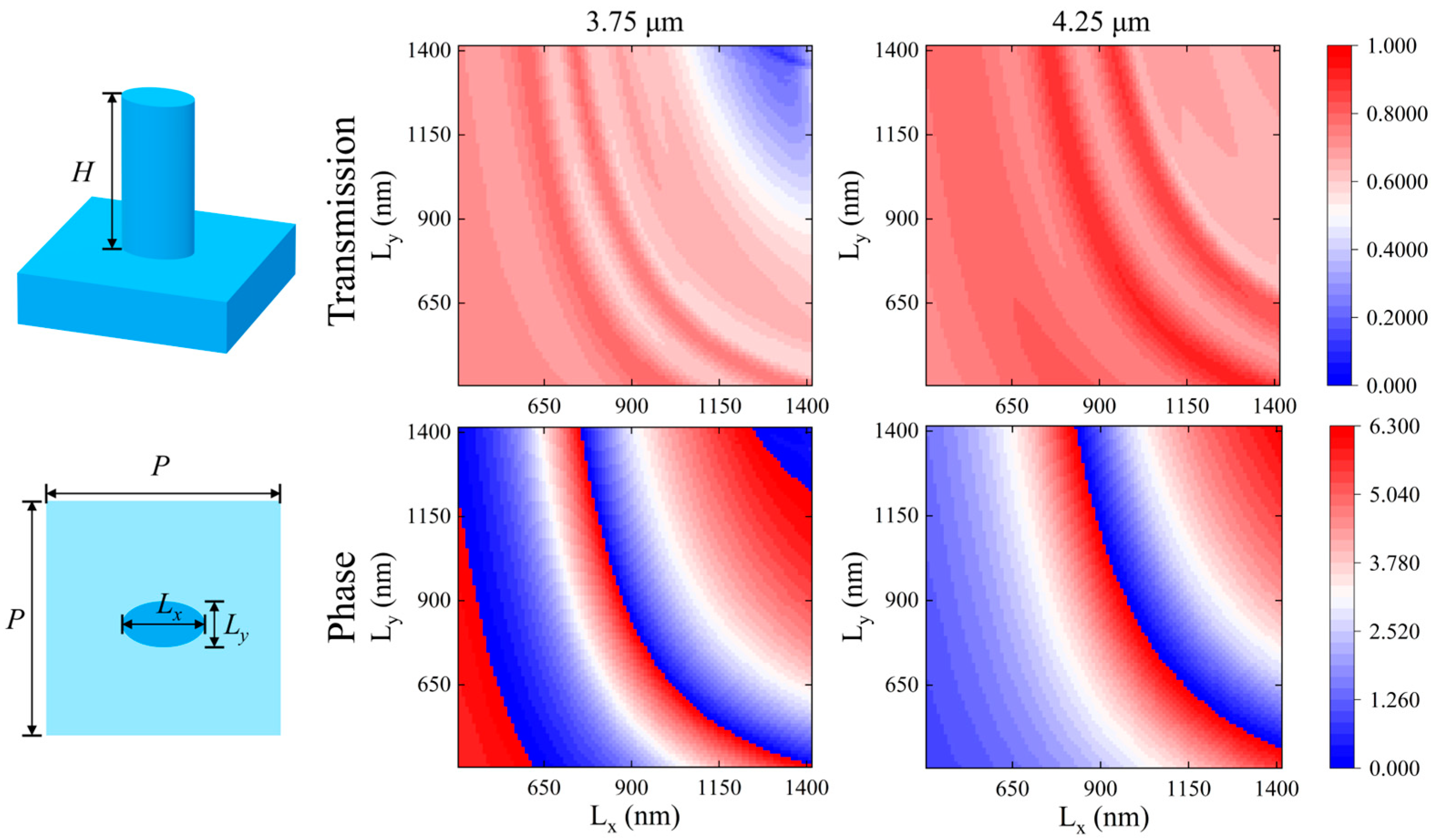
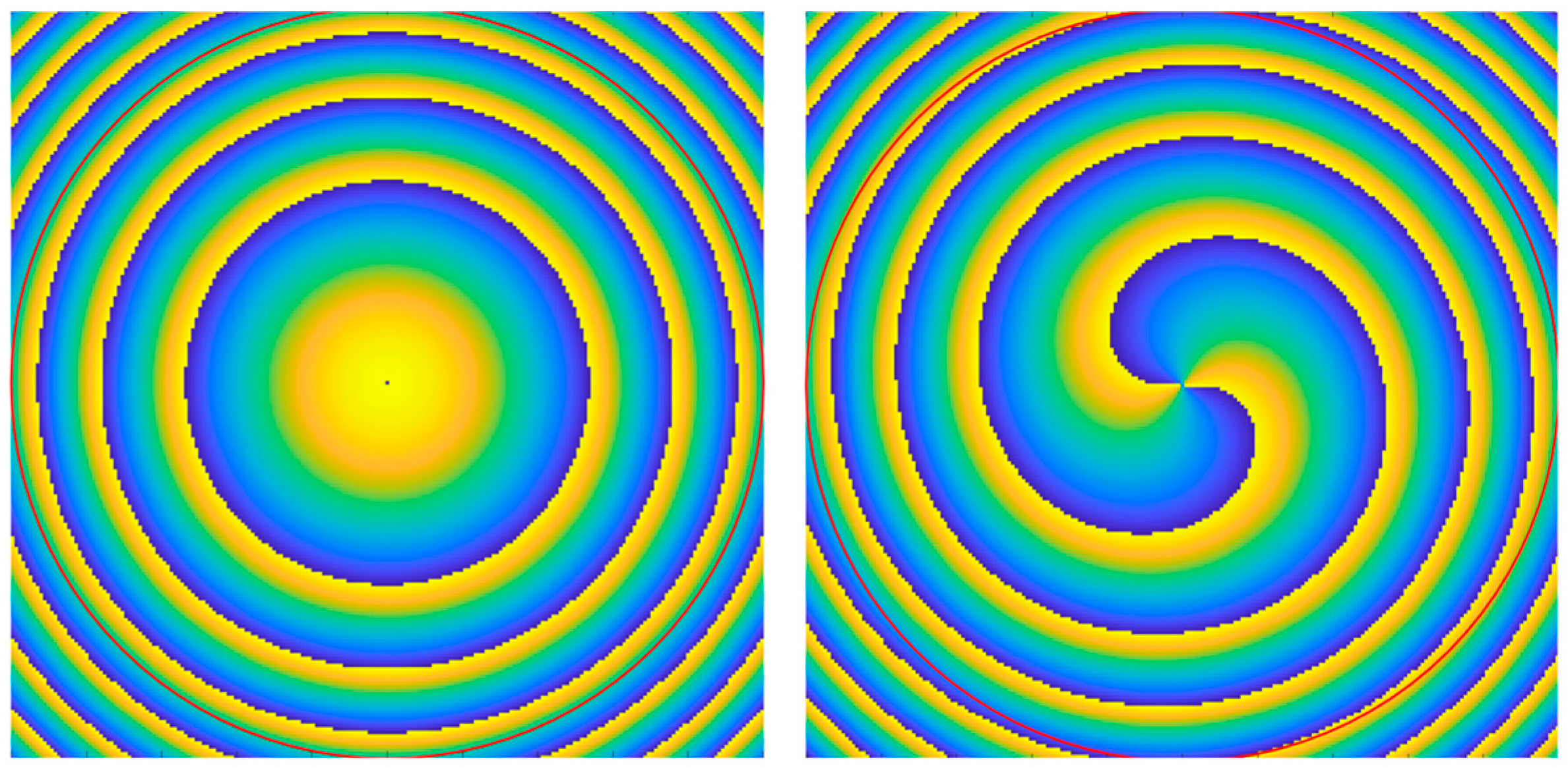


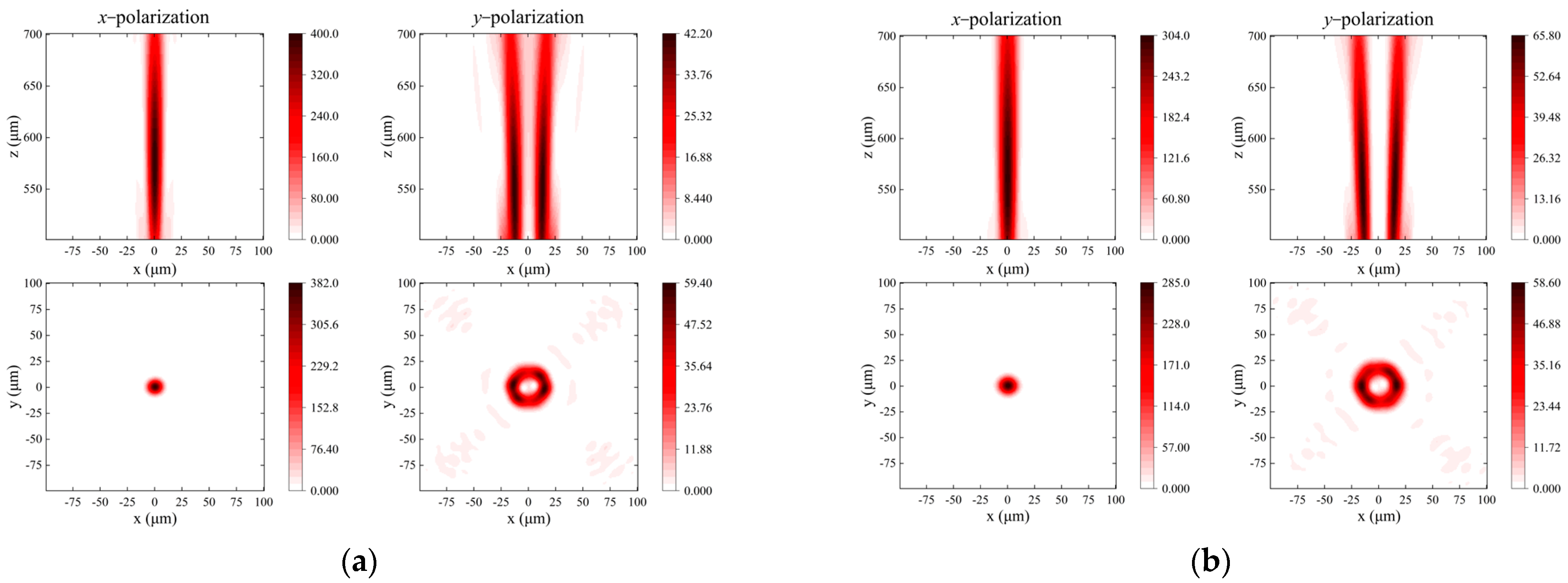
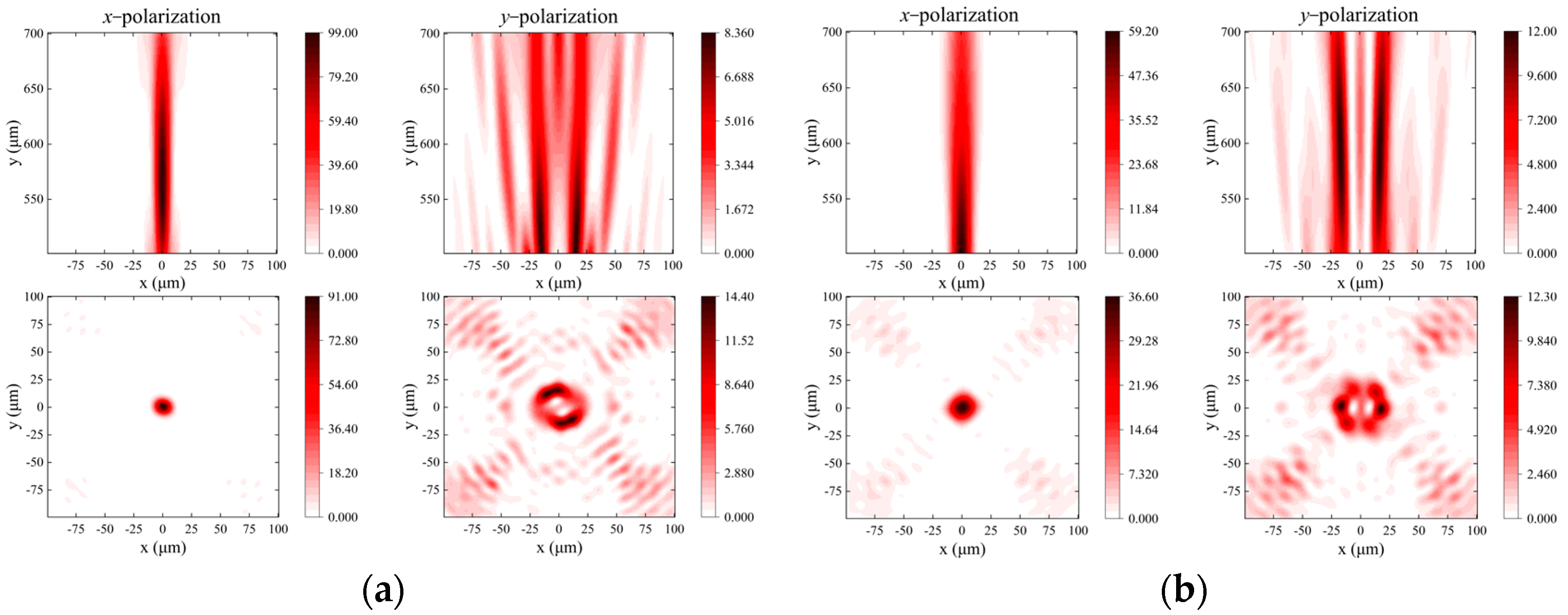
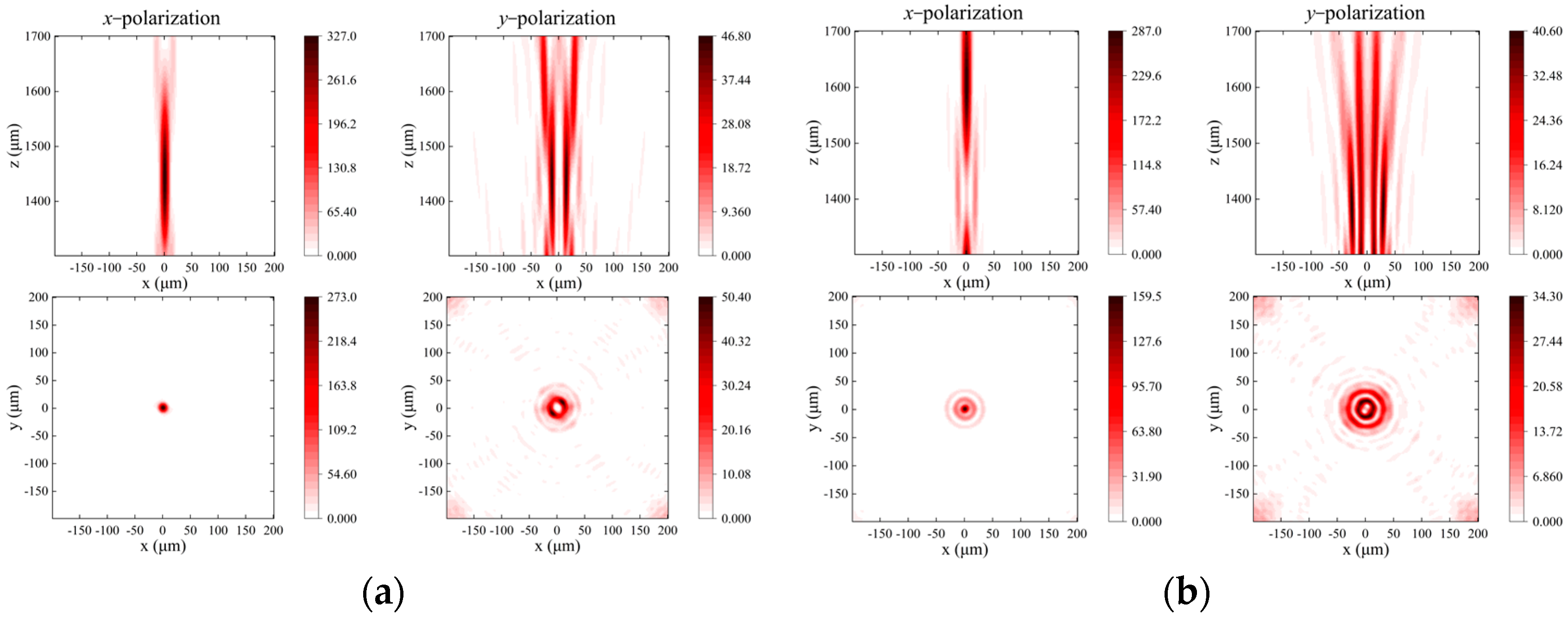


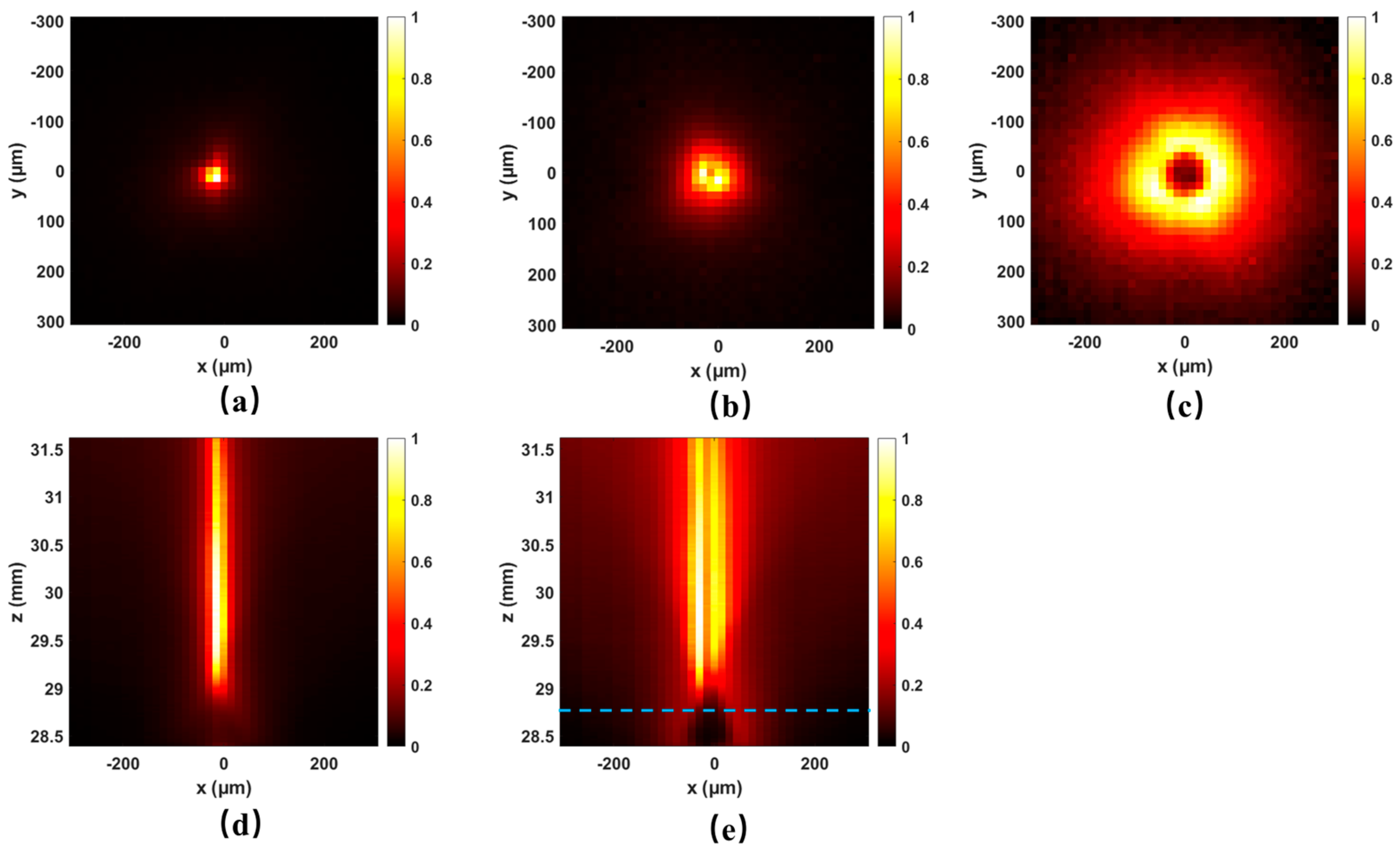


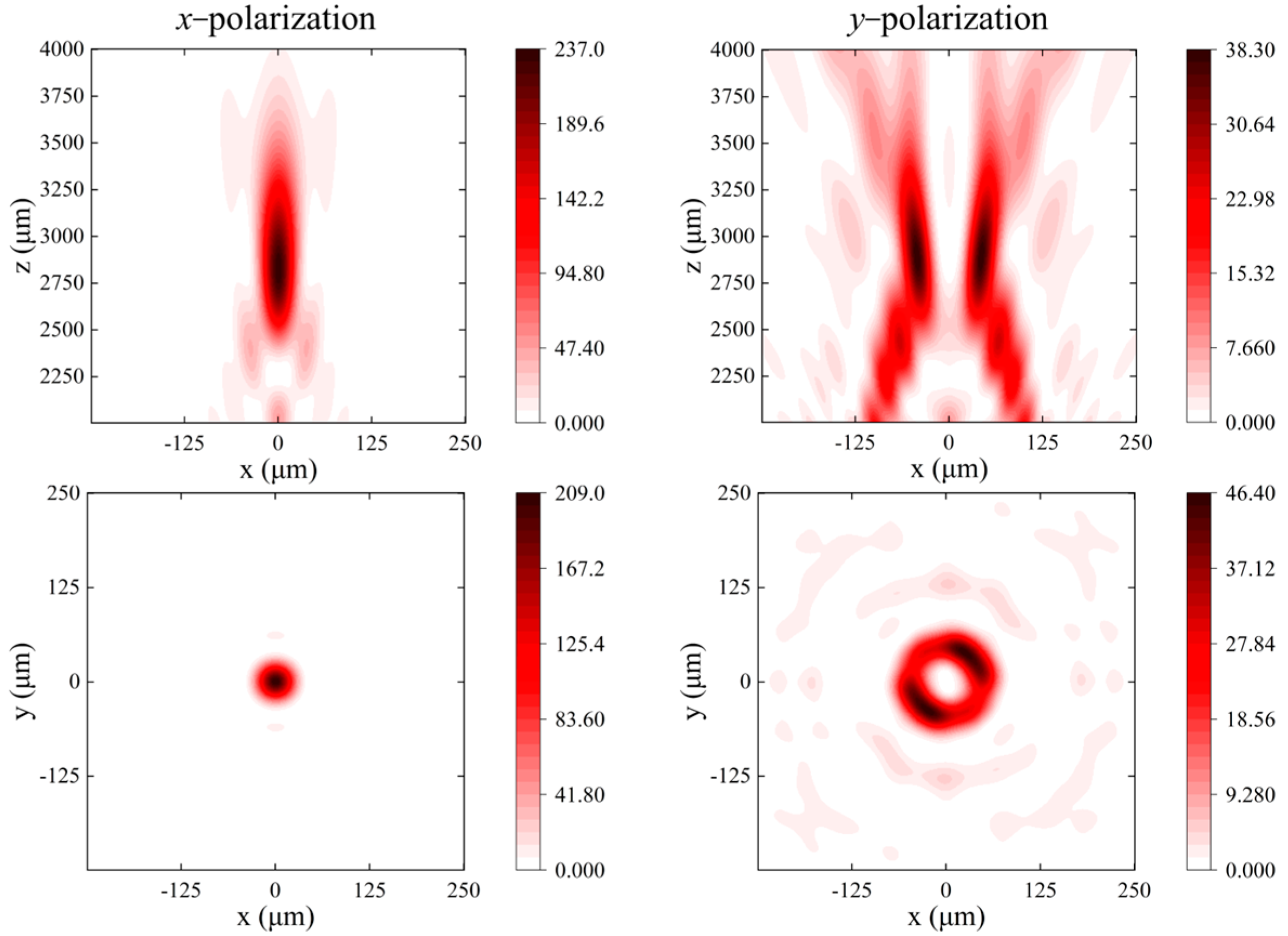
| Working Wavelength | Function | Aperture Size | Focusing Efficiency | ||
|---|---|---|---|---|---|
| Literature [19] | 0.4–0.7 μm | Polarization Function Multiplexing | 324 μm | ||
| Literature [25] | 1.2–1.68 μm | Achromatic Focusing | 55.55 μm | 8.4%, 12.44%, and 8.56% | |
| Literature [26] | 3.5–5 μm | Polarization Function Multiplexing | 200 μm | ||
| Literature [27] | 3.5–5 μm | Achromatic Focusing, Vortex Beam Generation | 200 μm | 45% | |
| Literature [15] | 4–5 μm | Achromatic Focusing | 100 μm | 51.6% | |
| This work | 3.7–4.8 μm | Polarization Function Multiplexing | 10,000 μm | 43.77% | |
Disclaimer/Publisher’s Note: The statements, opinions and data contained in all publications are solely those of the individual author(s) and contributor(s) and not of MDPI and/or the editor(s). MDPI and/or the editor(s) disclaim responsibility for any injury to people or property resulting from any ideas, methods, instructions or products referred to in the content. |
© 2025 by the authors. Licensee MDPI, Basel, Switzerland. This article is an open access article distributed under the terms and conditions of the Creative Commons Attribution (CC BY) license (https://creativecommons.org/licenses/by/4.0/).
Share and Cite
Shang, X.; Huang, H.; Zhou, Y.; Gong, J.; Liu, Y.; Li, W. Dual-Wavelength Polarization Multifunction Metalens Based on Spatial Multiplexing. Photonics 2025, 12, 61. https://doi.org/10.3390/photonics12010061
Shang X, Huang H, Zhou Y, Gong J, Liu Y, Li W. Dual-Wavelength Polarization Multifunction Metalens Based on Spatial Multiplexing. Photonics. 2025; 12(1):61. https://doi.org/10.3390/photonics12010061
Chicago/Turabian StyleShang, Xiangshuo, Haiyang Huang, Yi Zhou, Jiaheng Gong, Yang Liu, and Wei Li. 2025. "Dual-Wavelength Polarization Multifunction Metalens Based on Spatial Multiplexing" Photonics 12, no. 1: 61. https://doi.org/10.3390/photonics12010061
APA StyleShang, X., Huang, H., Zhou, Y., Gong, J., Liu, Y., & Li, W. (2025). Dual-Wavelength Polarization Multifunction Metalens Based on Spatial Multiplexing. Photonics, 12(1), 61. https://doi.org/10.3390/photonics12010061





